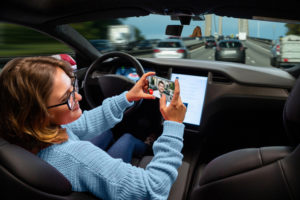A fully autonomous or self-driving vehicle is not available for sale to consumers, at least not yet. Any vehicle for sale to the public and marketed as “driverless” is not really driverless.
vehicle for sale to the public and marketed as “driverless” is not really driverless.
So, what does that mean?
While you are able to buy a car today that can automatically brake for you when the vehicle’s technology senses a collision, helps you stay within your lane, or assists you in parking, you still need an alert driver behind the wheel. This new technology’s ability remains limited, and drivers are supposed to continuously pay attention to the road. Even Tesla’s owner’s manual states that drivers are supposed to keep their hands on the wheel at all times, be ready to take over when the system is not able to steer, accelerate or brake on its own.
The Society of Automotive Engineers defines 6 levels of driving automation ranging from 0 (fully manual) to 5 (fully autonomous) as follows:
Level 0 (No Driving Automation)
Most vehicles on the road today are Level 0 which means the driver performs all driving tasks, although there may be systems in place to help the driver. An example would be the emergency braking system?since it technically does not “drive” the vehicle, it does not qualify as automation.
Level 1 (Driver Assistance)
This is the lowest level of automation. The vehicle typically features a single automated system for driver assistance which can assist the driver with either steering or braking/accelerating, but not both simultaneously. Adaptive cruise control, where the vehicle can be kept at a safe distance behind the next car, qualifies as Level 1 because the driver monitors the other aspects of driving such as steering and braking.
Level 2 (Partial Driving Automation)
These vehicles use Advanced Driver Assistance Systems (ADAS) and can control both steering and accelerating/decelerating. Here the automation falls short of self-driving because a human driver sits in the driver’s seat and can take control of the car at any time. Tesla Autopilot and Cadillac Super Cruise systems both qualify as Level 2.
Level 3 (Conditional Driving Automation)
The jump from Level 2 to Level 3 is substantial from a technological perspective, but subtle from a driver perspective.
Level 3 vehicles have “environmental detection” capabilities and can make informed decisions for themselves, such as accelerating past a slow-moving vehicle. But, they still require human override. The driver must remain alert and ready to take control if the system is unable to execute the task.
Two years ago, Audi (Volkswagen) announced the world’s first Level 3 production vehicle; however, while Audi was developing its marvel of engineering, the regulatory process in the U.S. shifted from federal guidance to state-by-state mandates for autonomous vehicles. So, while Audi rolled out the full Level 3 A8L in Europe, in the US, the A8L was shipped without key hardware and software required to achieve Level 3 functionality. In Europe, the Level 3 system would not require a driver to monitor the road and the liability in case of an accident when engaged would transfer to the automaker. While Audi withdrew production of a Level 3 vehicle in 2020, Honda announced last month the launch of a new car equipped with level 3 autonomous driving technology, paving the way for the automobile industry to continue its efforts to commercialize such automation for passenger vehicles.
Level 4 (High Driving Automation)
The key difference between Level 3 and Level 4 automation is that Level 4 vehicles can intervene if things go wrong or there is a system failure. In this sense, these cars do not require human interaction in most circumstances. However, a human still has the option to manually override.
Level 4 vehicles can operate in self-driving mode, but until legislation and infrastructure evolves, they can only do so within a limited area (usually an urban environment where top speeds reach an average of 30mph). This is known as geofencing. As such, most Level 4 vehicles in existence are geared toward ridesharing. For example:
- Navya, a French company, is already building and selling Level 4 shuttles and cabs in the U.S. that run fully on electric power and can reach a top speed of 55 mph.
* Alphabet’s Waymo recently unveiled a Level 4 self-driving taxi service in Arizona, where they had been testing driverless cars?without a safety driver in the seat?for more than a year and over 10 million miles. - Canadian automotive supplier Magna has developed technology (MAX4) to enable Level 4 capabilities in both urban and highway environments. They are working with Lyft to supply high-tech kits that turn vehicles into self-driving cars.
- Just a few months ago, Volvo and Baidu announced a strategic partnership to jointly develop
- Level 4 electric vehicles that will serve the robotaxi market in China.
Level 5 (Full Driving Automation)
Level 5 vehicles do not require human attention — the “dynamic driving task” is eliminated. Level 5 cars won’t even have steering wheels or acceleration/braking pedals. They will be free from geofencing, able to go anywhere and do anything that an experienced human driver can do. Fully autonomous cars are undergoing testing in several pockets of the world, but none are yet available to the general public.
While these technology systems can be helpful and are meant to improve safety, it is important to remember that at the current time, they are only there to assist the driver. Every vehicle currently for sale in the United States requires the full attention of the driver at all times for safe operation.
References
- Society of Automotive Engineers – https://www.sae.org/standards/content/j3016_201806/
* Advanced Driver Assistance System – https://www.synopsys.com/automotive/what-is-adas.html - CNet Road Show – Why the 2019 Audi A8 Won’t Get Level 3 Partial Automation in the US – https://www.cnet.com/roadshow/news/2019-audi-a8-level-3-traffic-jam-pilot-self-driving-automation-not-for-us/
- Motor Authority – Navya Already Sells Fully Self-Driving Cars, Including in US – https://www.motorauthority.com/news/1118809_navya-already-sells-fully-self-driving-cars-including-in-us
- Reuters – Waymo Unveils Self-Driving Taxi Service in Arizona for Paying Customers – https://www.reuters.com/article/us-waymo-selfdriving-focus/waymo-unveils-self-driving-taxi-service-in-arizona-for-paying-customers-idUSKBN1O41M2
- Magna – MAX 4: Magna’s Formula for Winning the Self-Driving Car Race –https://www.magna.com/insights/article/max4-magna-s-formula-for-winning-the-self-driving-car-race
- Auto News – Volvo, Baidu Team Up for Level 4 Autonomous EVs in China – https://www.autonews.com/article/20181101/MOBILITY/311019997/volvo-baidu-team-up-for-level-4-autonomous-evs-in-china


